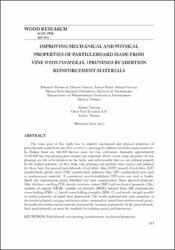IMPROVING MECHANICAL AND PHYSICAL PROPERTIES OF PARTICLEBOARD MADE FROM VINE (VITIS VINIFERA L.) PRUNINGS BY ADDITION REINFORCEMENT MATERIALS
Abstract
The main goal of this study was to improve mechanical and physical properties of particleboards made from vine (Vitis vinjfera L.) prunings by addition of reinforcement materials. In Turkey, there are 462.000 hectare areas for vine cultivation. Annually, approximately 2.345.000 ton vine pruning parts residues are remained. Every season, large quantities of vine prunings are left as by-products in the fields, and unfortunately they are not utilized properly by the related industries. In this study, vine prunings and particles were used as raw material for three-layer flat pressed particleboards. Cord fabric fibre (CFF) (mixed), Cord fabric (CF) (sandwiched), plaster mesh (PM) (sandwiched), polyester fibre (PF) (sandwiched) were used as reinforcement materials. A commercial urea-formaldehyde (UF) resin was used as binder. Small size experimental panels (56x56x2 cm) were manufactured. Some physical properties (like, thickness swelling (TS), density, moisture content (MC) and mechanical properties (like, modulus of rupture (MOR), modulus of elasticity (MOE), internal bond (IB) perpendicular screw-holding (PSH, perpendicular to), lateral screw-holding strengths (SHS, //), and tensile strength parallel to surface properties of panels were determined. The results indicated that some properties of the reinforced panels can give satisfactory values compared to control (non reinforcement) panels. Generally the reinforcement materials increased the mechanical properties of the particleboards. Such particleboards can meet the standards for isolation panels and interior-use.


















